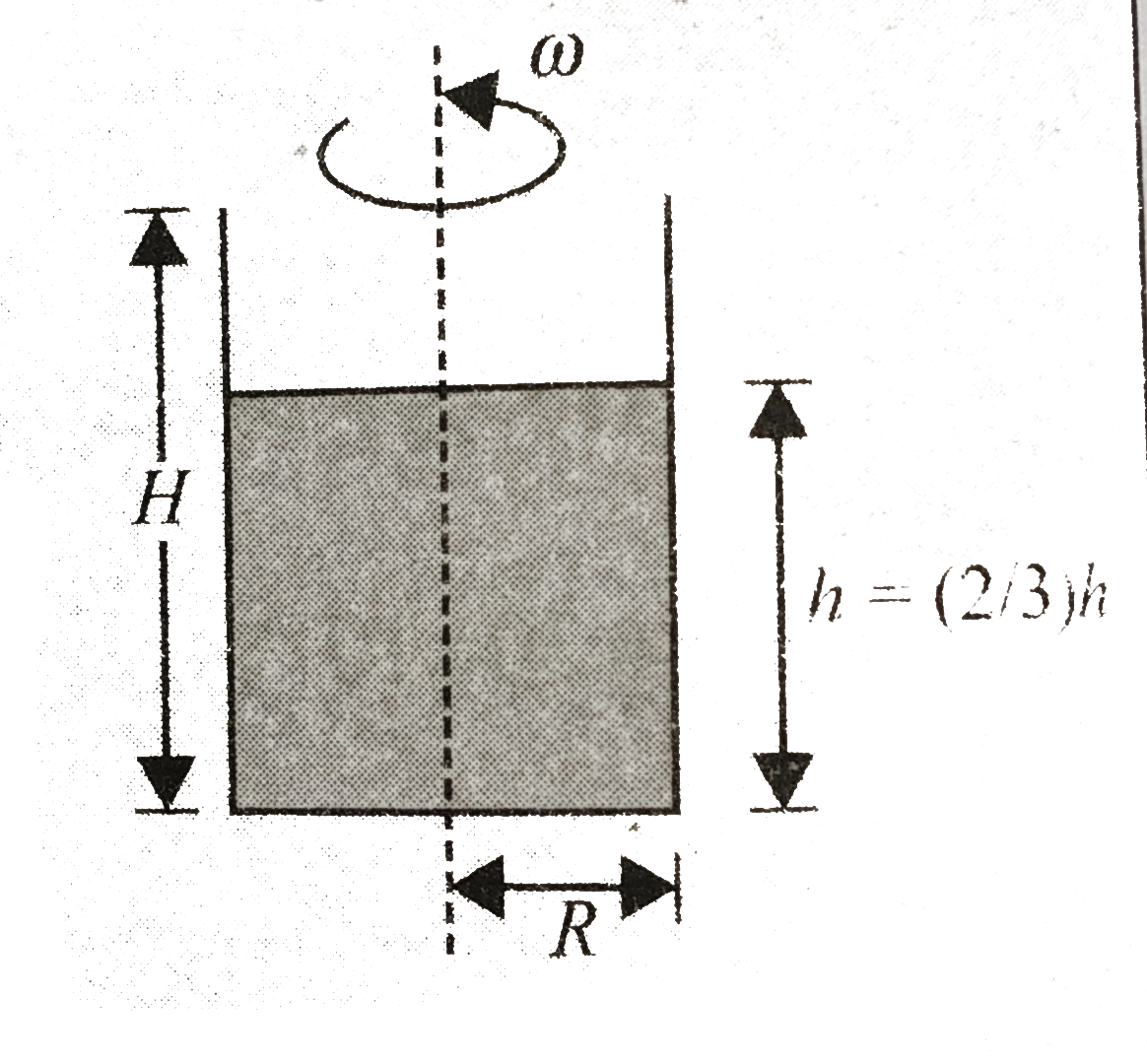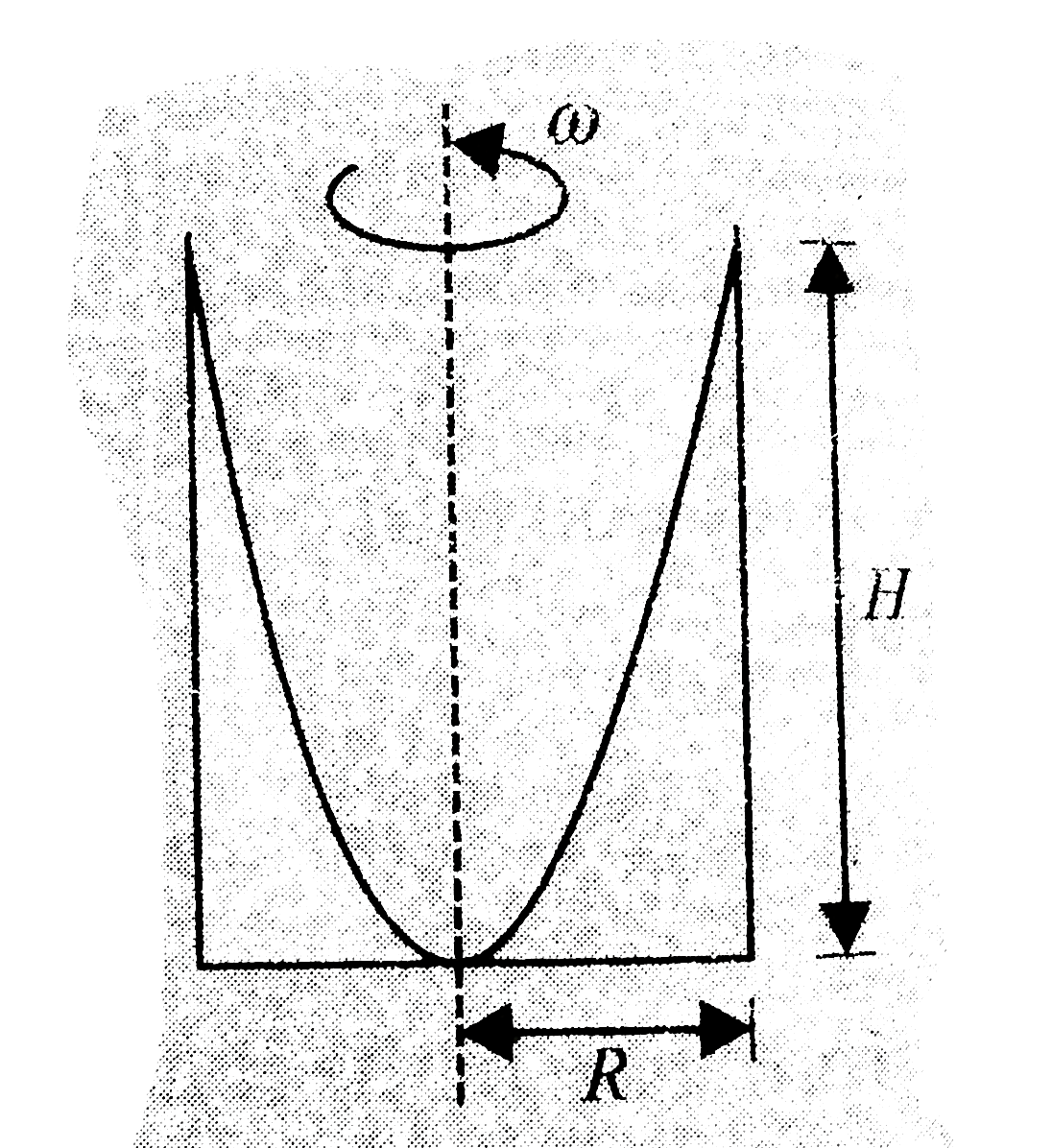A cylindrical tank of radius and height has water up to of height. What will be the rise in level of liquid at the periphery if the cylinder be given an angular velocity of ? Also determine the frequency of rotation when water just starts spilling over the sides of the vessel.
To solve the problem, we will break it down into two parts:
1. Finding the rise in the level of liquid at the periphery when the cylinder is given an angular velocity.
2. Determining the frequency of rotation when the water just starts spilling over the sides of the vessel.
Part 1: Rise in Level of Liquid at the Periphery
Step 1: Understand the forces acting on the water.
- When the cylindrical tank rotates, the water experiences a centrifugal force that pushes it outward. The surface of the water will form a slope due to this force.
- The forces acting on a small element of water at radius r are the gravitational force mg acting downwards and the centrifugal force mω2r acting outward.
Step 2: Relate the angle of the surface to the forces.
- The angle θ that the surface makes with the horizontal can be found using the balance of forces:
tanθ=centrifugal forceweight=ω2rg
Step 3: Express the rise in height at the periphery.
- The height difference dy at a distance r from the center can be expressed as:
dy=rtanθ=rω2rg=ω2r2g
- For the maximum radius R=20cm=0.2m:
dy=ω2R2g
Step 4: Substitute the values.
- Given ω=10rad/s and g≈9.81m/s2:
dy=(10)2(0.2)29.81=100×0.049.81≈49.81≈0.407m≈4.07cm
Part 2: Frequency of Rotation When Water Just Starts Spilling
Step 5: Determine the maximum height of water before spilling.
- The height of the tank is 50cm and the initial height of water is 30cm. Therefore, the maximum rise ΔH before spilling is:
ΔH=50cm−30cm=20cm=0.2m
Step 6: Set up the equation for maximum height before spilling.
- Using the same formula for dy:
0.2=ω2R2g
- Rearranging gives:
ω2=0.2gR2
Step 7: Substitute the values to find ω.
- Substitute g≈9.81m/s2 and R=0.2m:
ω2=0.2×9.81(0.2)2=1.9620.04=49.05
ω=√49.05≈7rad/s
Step 8: Calculate the frequency of rotation.
- The frequency f is given by:
f=ω2π=72π≈76.283≈1.11Hz
Final Answers:
1. The rise in the level of liquid at the periphery is approximately 4.07 cm.
2. The frequency of rotation when water just starts spilling over is approximately 1.11 Hz.
2. Determining the frequency of rotation when the water just starts spilling over the sides of the vessel.
- When the cylindrical tank rotates, the water experiences a centrifugal force that pushes it outward. The surface of the water will form a slope due to this force.
- The forces acting on a small element of water at radius r are the gravitational force mg acting downwards and the centrifugal force mω2r acting outward.
- The angle θ that the surface makes with the horizontal can be found using the balance of forces:
tanθ=centrifugal forceweight=ω2rg
- The height difference dy at a distance r from the center can be expressed as:
dy=rtanθ=rω2rg=ω2r2g
- For the maximum radius R=20cm=0.2m:
dy=ω2R2g
- Given ω=10rad/s and g≈9.81m/s2:
dy=(10)2(0.2)29.81=100×0.049.81≈49.81≈0.407m≈4.07cm
- The height of the tank is 50cm and the initial height of water is 30cm. Therefore, the maximum rise ΔH before spilling is:
ΔH=50cm−30cm=20cm=0.2m
- Using the same formula for dy:
0.2=ω2R2g
- Rearranging gives:
ω2=0.2gR2
- Substitute g≈9.81m/s2 and R=0.2m:
ω2=0.2×9.81(0.2)2=1.9620.04=49.05
ω=√49.05≈7rad/s
- The frequency f is given by:
f=ω2π=72π≈76.283≈1.11Hz
1. The rise in the level of liquid at the periphery is approximately 4.07 cm.
2. The frequency of rotation when water just starts spilling over is approximately 1.11 Hz.
Topper's Solved these Questions
- FLUID MECHANICSBook:CENGAGE PHYSICS ENGLISHChapter:FLUID MECHANICSExercise:Solved Examples
Explore 7 Videos
- FLUID MECHANICSBook:CENGAGE PHYSICS ENGLISHChapter:FLUID MECHANICSExercise:Exercise 4.1
Explore 11 Videos
- DIMENSIONS & MEASUREMENTBook:CENGAGE PHYSICS ENGLISHChapter:DIMENSIONS & MEASUREMENTExercise:Integer
Explore 2 Videos
- GRAVITATIONBook:CENGAGE PHYSICS ENGLISHChapter:GRAVITATIONExercise:INTEGER_TYPE
Explore 1 Video
Similar Questions
A cylindrical container with internal radius of its base 10 cm, contains water up to a height of 7 cm. Find the area of the wet surface of the cylinder.
View SolutionA cylinder of radius R=1m and height H=3m two- thirds filled with water, is rotated about its vertical axis as shown in Fig. Determine the speed of rotation when
a. the: water just starts spilling over the rim.
b. the point at the centre of the base is just exposed.

View SolutionA cylindrical vessel of diameter 0.3m and height 0.6m is filled two thirds with a liquid of specific gravity 0.8. The vessel is rotated about its axis. a. Determine the speed of rotation when the liquid just starts spilling. b.Find the speed of rotation when the base is just visible. c. What is the percentate of liquid left in the vessel?
View SolutionA cone of a radius 5 cm is filled with water. If the water poured in a cylinder of radius 10cm, the height of the water rises 2 cm, find the height of the cone.
View SolutionA cone of a radius 5cm is filled with water. If the water poured in a cylinder of radius 10cm, the height of the water rises 2cm, find the height of the cone.
View SolutionA cylinder of radius R and height H is foam unknown height h. When is rotated at an unknown constant angular velocity ω, the base of the cylinder gets exposed when the liquid just starts spilling out, as shown in Fig.
a. Find the height h of the liquid.
b. Find the angular speed w of the cylinder.

View SolutionA cylindrical vessel with internal diameter 10 cm and height 10.5 cm is full of water. A solid cone of base diameter 7 cm and height 6 cm is completely immersed in water. Find the volume of water (i) displaced out of the cylinder (ii) left in the cylinder. (Take π=22/7 )
View SolutionA cylindrical beaker, whose base has a radius of 15 cm, is filled with water up to a height of 20 cm. A heavy iron spherical ball of radius 10 cm is dropped to submerge completely in water in the beaker. Find the increase in the level of water.
View SolutionA glass cylinder with diameter 20 cm has water to a height of 9 cm. A metal cube of 8 cm edge is immersed in it completely. Calculate the height by which water will rise in the cylinder. (Take π=3.142)
View SolutionA glass cylinder with diameter 20 cm has water to a height of 9 cm. A metal cube of 8 cm edge is immersed in it completely. Calculate the height by which water will rise in the cylinder. (Take π=3.142)
View Solution